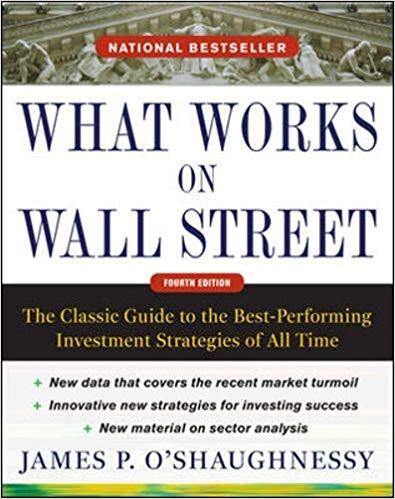What Works on Wall Street
Review What Works on Wall Street: A Guide to the Best-Performing Investment Strategies of All Time
by JAMES P. O’SHAUGHNESSY
Description
A shortcut to a must-take road of financial pilgrimage in Wall Street, What Works on Wall Street gives investors the easy way of finding out what really works, including those that don’t on Wall Street. Investors can select and pick effective and tested strategies to achieve their financial goals as they invest.
Wall Street is investing plays the “survival of the fittest” game. For this reason, investors of all sorts are always on the lookout to have the edge over the sea other investors out there. O’Shaughnessy finally shows investors the way to strategic investing and released the most anticipated investing book in the late ‘90s. After a couple of decades, the book remains relevant to modern-day investing as it presents a universal, practical guide to successful investing.
About the Author
James Patrick O’Shaughnessy founded O’Shaughnessy Asset Management. A successful investor, O’Shaughnessy has honed his investing skills mastering research decisions, investment models, quantitative equity analysis, and portfolio management. He has published a number of books including Invest Like the Best, How To Retire Rich, and What Works on Wall Street. O’Shaughnessy is dubbed by Forbes.com as a legendary investor.
Table of Contents
The book is composed of the following topics:
INTRO
CHAPTER 1: Stock Investment Strategies: Different Methods, Similar Goals
CHAPTER 2: The Unreliable Experts: Getting In The Way Of Outstanding Performance
CHAPTER3: The Persistence Of Irrationality: How Common Mistakes Create Tremendous Opportunity
CHAPTER4: Rules Of The Game
CHAPTER5: Ranking Stocks By Market Capitalization: Size Matters
CHAPTER 6: Price-To-Earnings Ratios: Separating The Winners And Losers
CHAPTER 7: EBITDA-To-Enterprise Value
CHAPTER 8: Price-To-Cash Flow Ratios: Using Cash To Determine Value
CHAPTER 9: Price-To-Sales Ratios
CHAPTER 10: Price-To-Book Value Ratios: A Long-Term Winner With Long Periods Of Underperformance
CHAPTER 11: Dividend Yields: Buying An Income
CHAPTER 12: Buyback Yield
CHAPTER 13: Shareholder Yield
CHAPTER 14: Accounting Ratios
CHAPTER 15: Combining Value Factors Into A Single Composite Factor
CHAPTER 16: The Value Of Value Factors
CHATER 17: One-Year Earnings Per Share Percentage Changes: Do High Earnings Gains Mean High Performance?
CHAPTER 18: Profit Margins: Do Investors Profit From Corporate Profits?
CHAPTER 19: Return On Equity
CHAPTER 20: Relative Price Strength: Winners Continue To Win
CHAPTER 21: Using Multifactor Models To Improve Performance
CHAPTER 22: Dissecting The Market Leaders Universe: The Ratios That Add The Most Value
CHAPTER 23: Dissecting The Small Stocks Universe: The Ratios That Add The Most Value
CHAPTER 24: Sector Analysis
CHAPTER 25: Searching For The Ideal Growth Strategy
CHAPTER 26: Searching For The Ideal Value Stock Investment Strategy
CHAPTER 27: Uniting The Best From Growth And Value
CHAPTER 28: Ranking The Strategies
CHAPTER 29: Getting The Most Out Of Your Equity Investments
